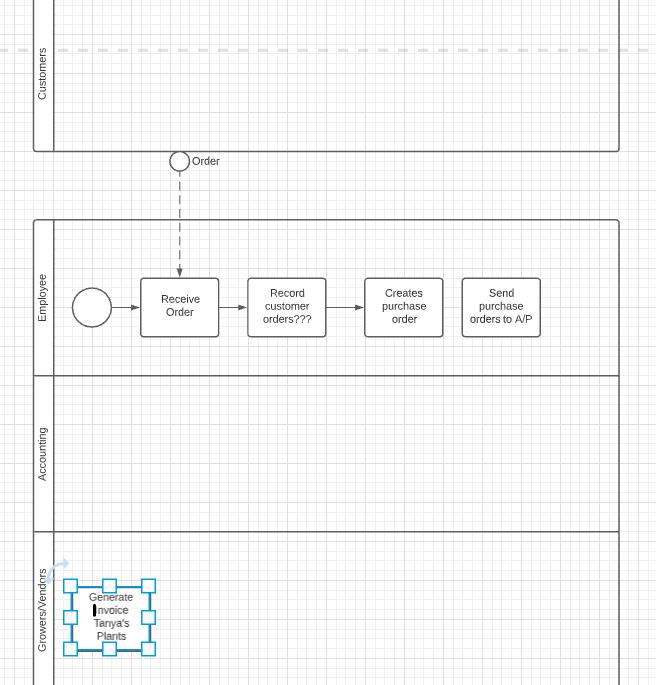Question
Construct BPMN(Business Process Model & Notation) flowcharts to represent the processes using Lucidchart or another flowcharting tool. You can combine all of the processes into
Construct BPMN(Business Process Model & Notation) flowcharts to represent the processes using Lucidchart or another flowcharting tool. You can combine all of the processes into one pool for Tanya’s with multiple lanes, or you can create separate diagrams for different parts of the business, one for the sales and Cash Receipt processes, for example. (Please check my example screenshot to get an idea of what the BPMN flowchart is supposed to look like. Please make it simple and not too complicated )

Tanya’s Tropical Plants You have recently taken on the role as chief accountant for Tanya’s Tropical Plants. Tanya and her staff have been recording information in Excel spreadsheets, and Tanya would like you to organize her books and automate financial reporting using Access. Your first step is to make sure you understand Tanya’s operations. You begin by interviewing Tanya and her employees so that you can understand the business processes and how data are gathered and used. These are the processes as you understand them. Tanya’s Tropical Plants, headquartered in Portland, OR, buys and sells tropical plants across the US. The company currently has 12 warehouses that serve as distribution centers, which are also referred to as “stores”. Tanya is interested in efficiency and volume. She sells only one size plant, which is planted in her branded, self-watering pot. Tropical plants are fragile, so Tanya doesn’t maintain inventory. Every day, her company purchases plants from large growers process them in the warehouses, and distributes them to her customers, which are typically small plant stores. Tanya maintains consistently low prices, which are based on her expected cost of purchasing the plants. Customers call to place orders for future deliveries.
Usually, they order about one week in advance. One order can involve several types of plants. The supervisors of the distribution centers know most of the customers by name and the types of plants they prefer. They also know what types of plants may not be available, so they try to steer the orders to other plants. They record customer orders in an Excel-based order log. Every morning, distribution center employees review customer orders to be delivered that day. They create purchase orders for distribution centers and send out employees to pick up plants from growers. They select the plants and load the truck. The growers then give them invoices listing the quantities and prices of the plants they have purchased. The trucks return to the warehouses. As the plants are unloaded the supervisors check the invoices for errors. They call growers to address any errors and then scan and email the purchase orders and invoices to the accounts payable clerk in Portland. Employees inspect the plants, put the plants into pots, and trim and water them as needed. They then sort the plants to fill individual customer orders, box up the orders, and put them back in the trucks to deliver to customers. Supervisors then prepare the sales order documents. Those documents list the customers’ original order number, the order date, the sale date, the truck #, and the quantities and prices of the plants. The sales documents are given to the customers along with the plants. After delivery, each supervisor updates the order log with the delivery information. Then each week, the supervisor emails copies of the updated order log to accounts payable.
Customers pay for all their deliveries at the end of the month, sending payments to the accounts receivable clerk in Portland. For pots and routine administrative purchases, supervisors place orders over the phone. Then, the vendor supplies the products or services and sends an invoice. The supervisor stamps the invoice as received scans the document, and emails it to accounts payable. The accounts payable clerk prepares checks for payments to growers and other vendors at the end of each month. After processing the payments through an online banking application, the clerk updates the AP spreadsheet and emails the cash disbursement records. You will be receiving these records from now on. The accounts receivable clerk receives payments from customers at the end of each month. The A/R clerk assigns sequential cash receipt numbers to each incoming payment, recording the customer number, the receipt date, and the receipt amount in a spreadsheet. Each day, the clerk deposits all checks received in the bank and then emails the list of cash receipts along with a copy of the deposit slip. You will be receiving those from now on.
Customers Accounting Growers/Vendors O Generate 17 Invoice Tanya's Plants 1 Order Receive Order Record customer orders??? T Creates purchase order Send purchase orders to A/P LE
Step by Step Solution
3.34 Rating (157 Votes )
There are 3 Steps involved in it
Step: 1
Heres a simple BPMN flowchart that represents the processes involved in Tanyas Tropical Plants Tanya...
Get Instant Access to Expert-Tailored Solutions
See step-by-step solutions with expert insights and AI powered tools for academic success
Step: 2

Step: 3

Ace Your Homework with AI
Get the answers you need in no time with our AI-driven, step-by-step assistance
Get Started


